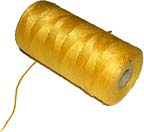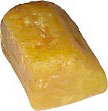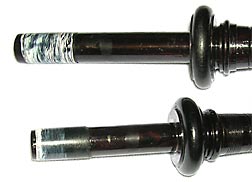  |
||
 |
 |
 |
 |
 |
||
| reference articles | competition journal | piping links | FAQ | contact me |
Andrew's Tips: How to Hemp Tuning PinsBy Andrew T. Lenz, Jr., Santa Cruz, California, ©2003-March 20, 2011As with most aspects of bagpiping, there are a lot of varying opinions as to how to best hemp the tuning pins on your bagpipes' drones. The term "hemping" comes from the time of when the string material used to wrap the tenon* of a tuning pin was, in fact, made from hemp. These days it's made of linen and is usually found in one of two colors: yellow and black. What everyone agrees onIn order to tune your drones, the upper section of the drone must slide up and down (usually twisting at the same time) on the tuning pins using one hand—but not so loose that they move unintentionally.* Also, for sake of tonal quality, you'd like the tuning pins to be as airtight as possible, again this means you don't want them to be too loose such as rocking side to side. *A part of a functional drone is a base that is very securely in its corresponding stock. If your stock joint is too loose, it will slip and rotate when you are trying to tune your drone. Materials used in hemping your pinsHere's a quick run down on different items used (or were used) for sealing your tuning joints. Yellow Unwaxed Hemp (linen). This string is dyed yellow and is quite strong. Black Waxed Hemp (linen). This string is dyed black, is saturated with a sticky wax and is quite strong. Yellow Waxed Hemp (linen). Just like the black waxed hemp, but dyed yellow instead and is slightly thinner. Cobbler's Wax (resin). This black sticky resin is applied by those who want to create a very sticky hemp. This resulting hemp would be used as a solid base for top layers of a less sticky hemp. Beeswax. Another wax commonly used to wax unwaxed hemp. Beeswax is on the "sticky side" of waxes. Not too many decades ago, waxed hemp was unavailable—or at least, not introduced to the piping community—so you had to make your own. Some people prefer to use this old method. Waxed Dental Floss (Unflavored). This very easy to get item can be used on the pins when waxed hemp is too thick, but you need it just a little bit tighter. Not the most aesthetically pleasing to the eye—and hence not very common—but stays in place over waxed hemp if pressed in well. Toilet Seal Wax. Toilets typically use an large oily wax ring to seal their connection with the sewer pipe at the floor. These seals are quite cheap and are readily available at a hardware store. Some piper discovered that this oil-impregnated wax works very nicely as a lubricant for tuning pins. One down side to this method is you may find lint/grime from your pipe case sticking to your exposed pins, or the wax rubbing off on your bag cover. Parafin/Candle Wax. Some pipers like to use parafin as the final outer coating of the hemping to provide a smooth slide. Parafin is available at grocery stores and any store selling candle-making supplies. Cork. Well, cork is not usually a do-it-yourself project, though it can be. If you aren't comfortable tackling this, it's best sent off to someone who does it on a regular basis. Cork was the common method of preparing sliding joints (and the chanter) up until the early part of the 20th century. It works pretty well, but it can sometimes dry out and shed if not cared for properly. Cork grease should be applied when needed and your pipes should be disassembled after each use in a manner that allows the cork to expand back to its uncompressed state. Cork grease. Cork grease is designed for preserving and lubricating cork fittings on wind instruments—such as are still common on clarinets. (There are different types, avoid cork grease made from petroleum.) Some pipers use cork grease over their hemping to ease sliding. Teflon Tape (PTFE)/Plumber's Tape. This inexpensive slippery (non-adhesive) white tape is easily available at almost all hardware stores in 1/2" widths and is used to provide a snug but easily moveable fit. There are a few otherwise very reputable pipers that claim that Teflon tape was designed for water lines and therefore is ineffective as an air seal. This argument is erroneous. Not only is Teflon tape used to seal air lines, there is a thicker version specifically made for gas lines! (This gas line version, identified by a light yellow tint, is too thick and is ill suited for fine adjustments to your tuning pins.) "Teflon" is a trademark of DuPont.
The Different ApproachesNote: "Waxed hemp" in terms of a "bottom layer" in the following approaches includes both manufactured waxed hemp as well as hemp prepared with sticky cobbler's wax. 1) Unwaxed hemp only. This type of joint will be more spongy than a solely waxed hemp joint and can seal well as a result. But unwaxed hemp absorbs moisture and can swell to the point of causing tuning problems. Another issue with unwaxed yellow hemp is that it doesn't stick to itself and you often end up with the common problem of the outer layers of hemp sliding around on the inner layers and then tuning is impossible. 2) Waxed hemp for the bottom layers, unwaxed for top. This is a pretty common method. The more unwaxed layers you have on the top, the more this connection will swell and require a differing torque to move. 3) Waxed hemp entirely. This is also an accepted method. If the fit is too tight, unwrap some of the hemp, add some waxed dental floss, or scrape wax off the outer hemp layer with a blade—or slip into the method in the next paragraph. 4) Waxed hemp for the bottom layers, maybe a thin middle layer of unwaxed hemp, Teflon for top. This is a pretty common method. Again, the more unwaxed layers you have on the top, the more this connection can swell and require a differing torque to move, though if it's covered completely by the Teflon tape, the tape can act as moisture barrier. Teflon slides extremely well. You may find that you will need to add tape as time goes on, since the tape is thin and wears. It's been said that you can effectively "thread" the pin each time by turning the drone top in one direction as you lower it onto the pin. The idea being that by turning it one direction it will rise and the opposite direction will lower it. Teflon can be a little unsightly if you don't like white tape sticking out from under your drone top, but this can be avoided for the most part by applying the tape to the pin only above the normal tuning position of your drone top. 5) Waxed hemp for the bottom layers, maybe a thin middle layer of unwaxed hemp, slippery wax for top. This is a pretty common method. The more unwaxed layers you have on the top, the more this connection will swell and require differing torque to move. Properly waxed pins slide extremely well, just don't use a sticky wax. Without a yellow layer of unwaxed hemp, your tuning pins will appear black if you use the black waxed hemp. A lot of pipers like this look, though some may opt for other methods anyway. 6) Waxed hemp for the bottom layers, maybe a thin middle layer of unwaxed hemp, cork grease on top. The cork grease is applied lightly, and slides very well. Debris can collect on the cork grease, but this can be avoided by applying the grease to the pin only above the normal tuning position of your drone top. In my humble opinion—a few will disagree—the base of any pin hemp job should be a waxed something—be it black waxed hemp, cobbler's waxed yellow hemp, etc. On top on that, use whatever you want that's unsticky: plain yellow hemp, Teflon, toilet seal wax, parafin. Some stick to unaltered black waxed hemp entirely, if that works for you, then do it.
How do I wrap it?It's pretty easy. Just place a length of the end of your hemp on the tenon parallel to your tuning pin, run it to the edge of tenon then turn the hemp 90 degrees and start wrapping around the pin over the end of the hemp toward the middle of the tenon. (Some pipers will double up their initial wrappings by cutting two strands and wrapping two at a time.) Keep wrapping until you get to the end then start back. If you are using waxed hemp, you'll probably want to mash your wrappings down after every few layers as best you can—after a certain point, rolling the tuning pin on a table will work well. Unwaxed hemp you will want to keep as tight as you can make it while wrapping. The following describes a method for the initial wrappings that will help prevent slippage (particularly if you are using less sticky hemp). With either single or doubled-up hemp, start by tying two half-hitch knots then wind the hemp onto the pin clock-wise until the half-way point, then tie two half-hitches and reverse the winding direction and finish the pin by winding counter-clockwise. Once at the end of the tenon, again tie two half-hitches. Repeat this process until you have three layers, then finish off the tenon with the preferred method. This will prevent the hemping from breaking loose from the tenon and rotating—rotating is deadly for tuning. Many pipers are successful without this method, but if you have rotation problems, this method may be the cure. Once you are done wrapping, rolling finished hemp on smooth hard surface (wood block, table) will help even out the hemping and make for a better seal of the drone joint. What to avoidThere's a temptation with Teflon tape method to overdo it. Just because you can fit more doesn't mean you should. Particularly over yellow hemp which will absorb moisture though any unsealed areas during playing. If your joint is too tight, then swells further, you run the risk of cracking your drones. This occurrence is less likely with some form of moisture trap in your bag, but is still undesirable nonetheless. Some go so far as to not recommend Teflon tape, so be careful. If your hemping is too loose, the drone top will shift or rock back and forth. If this is the case, it should be tightened up in some manner. You don't want your drone tuning position to change accidentally. AirtightnessWhile not ideal, air leaking out of your tuning pins really makes very little difference, unless it's really, really bad, then it will affect the acoustics a bit, perhaps introducing some instability. But it would have to be a very bad leak, and if that were the case, the drone top probably wouldn't be staying in position anyway which is a sure sign of necessary adjustment. "Help! It's show time and my drone top is too loose!"This is where beeswax or Teflon tape is wonderful. A few rubs around the hemping with beeswax will usually work in the pinch. Or a few wraps with Teflon tape. Your choice. Keeping one of these in your sporran wouldn't be a bad idea. Another option is roughening up the hemping with your fingernail resulting in more friction. Or if you have exposed hemping, you can moisten it with saliva to make it swell and seal better. "Help! It's show time and my drone top is too tight!"You idiot. Kidding, but it is in fact bad and should be strongly avoided. In this situation, depending on your hemping job, sometimes you can quickly scrape off some Teflon tape, but actually unwrapping hemping takes time. In a pinch, sometimes a drop of bore oil on the hemping can do the job—but a small amount can go a long way, avoid slathering it only to find that it slides too easily and then you have the opposite problem. Removing old hempWith either old yellow hemp or old waxed hemp, it may prove a challenge to remove it since it gets really hard to determine where the end is. Often times a careful slice with a sharp knife will help get things started. Last bit of adviceWhat works for you will depend on which method you find is easy for you do, how readily you can find certain materials, your climate, how you tune, how rough the internal bore of your drones are and other factors. Experiment with different approaches until you find what you like.
If you have comments or suggestions, please contact me. This page last updated Sunday, March 20, 2011. |
|||||||||||||||||||||||||
| sitemap | ||







